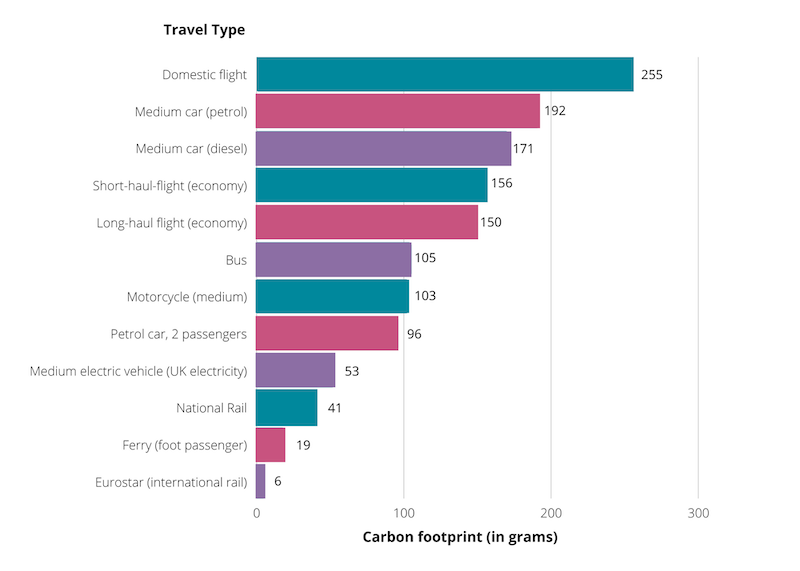
10 Ways To Reduce Carbon Footprint in Your Business
Why is reducing your carbon footprint important for businesses?
Businesses increasingly recognise the importance of reducing their carbon footprint. Not only are there environmental benefits of a more sustainable approach to energy consumption, but there are also the corporate social responsibility benefits of a positive perception of your brand. It helps employee engagement to become more sustainable and something more employees are demanding. There may also be an impact on your sales as more and more business owners are increasingly making purchasing decisions that are influenced by a potential vendors sustainability. Most importantly, due to the increasing UK legalisation it’s critical your business reduces it’s carbon footprint to demonstrate it is making steps towards the national net zero goals. Fortunately, there are numerous this can be done:
1) Travel Greener for Business Trips
Transport choice
UK Department of Energy & Industrial Strategy lists various forms of transport and the CO2-equivalent emissions they generate per passenger kilometre. As you might expect, flying and travelling by car are at the top of the list (see figure 1 below).
Medium-sized petrol and diesel cars emit an average of around 170g to 190g per passenger kilometre, while short and long-haul flights generate somewhere between 150g and 160g. Domestic flights are even worse, emitting around 255g per passenger mile.
Even so, there are many forms of transport that offer far lower CO2 emissions. For instance, a medium electric vehicle only emits 53g CO2 per passenger mile, and national rail emits just 41g. Ferry is even more environmentally-friendly, at just 19g per passenger mile.
As a business, therefore, prioritise rail and ferry travel over road and air. If you must use the road, switch to electric vehicles.
Figure 1. Carbon footprint of travel per kilometer, 2018
The carbon footprint of travel is measured in grams of carbon dioxide equivalents per pessenager kilometer. This includes carbon dioxide, but also other greenhouse gases, and increased warming from aviation emissions at attitude.
Source: UK Department of Energy & Industrial Strategy
Switch to Online Meetings and Online Events
Nothing beats the relationship built during face-to-face meetings and events, however do all meetings need to be done in person? One thing we’ve learnt from the pandemic is that business can be done more flexibly and not every meeting needs to be done in person. By using more online communication you reduce your CO2 emissions with less travel, but you also get more time back in your day.
Green Hotels
Buyers can review their suppliers for their sustainability credentials (more on this later) and you can do the same with your choice of hotel. Look out for official certifications as they vary across markets.
Understanding and Offsetting business travel
It is key to know how to calculate your carbon footprint so it can be analysed and understood as this sets the foundations to reducing your footprint. Once you know how much your business travel is contributing to your overall carbon consumption you can look at ways of offsetting your carbon emissions generated via business travel.
2) Invest in a Greener Office
Rough estimates suggest that the average office emits around 0.091 tonnes of CO2 per square metre, per year. That might not sound like much, but when you consider that business premises might occupy 20,000 square metres or more, the carbon impact adds up. A quick back-of-the-envelope calculation reveals that total CO2 generation for premises of this size is 1,820 tonnes per year.
Fortunately, there are numerous strategies you can adopt to reduce the carbon footprint of your office space. These include:
- Switching to energy-saving computer equipment, particularly those that use advanced processors
- Using high-energy rating kitchen appliances, such as fridges, microwaves, dishwashers and freezers
- Swapping out halogen and incandescent lighting for LEDs, reducing energy consumption by up to 80 percent
- Reducing thermostat temperature by a couple of degrees and encouraging colleagues to wear wooly jumpers during the winter months
- Installing automatic lighting that automatically switches off when colleagues are not present
3) Choose renewable energy suppliers
There is a growing amount of green energy providers on the market and making the switch to a renewable energy company is much easier than it once was. You may already have a green plan with your current energy supplier, otherwise you can consider switching energy supplier for one that meets your sustainable strategy and can promise that your level of energy consumption can come from renewable sources, it may be that with the amount you consume, this has to be a certain percentage. When reviewing suppliers look out for REGOs (Renewable Energy Guarantees of Origin) which assures that the origin of the energy purchased is 100% renewably sources. When your carbon footprint is calculated it does take into consideration the fuel mix of your electricity supply, and if you have 100% renewable sourced then your emissions for electricity will equal zero.
4) Pay For Carbon Offsetting
In some cases, technological limitations may prevent you from reducing your carbon footprint to zero. Under these circumstances, you can invest in carbon offsetting. These schemes recapture the CO2 that your enterprise generates and store it in some other form.
There are many different ways to do carbon offsetting. These include:
- Methane gas capture
- Reforestation
- Carbon capture schemes
Furthermore, businesses do not need to orchestrate carbon offset schemes directly. Instead, they can buy carbon offset credits and then allow other environmental organisations to implement projects on their behalf.
5) Boost Your Recycling Efforts
The next step is to boost your recycling efforts. Recycling has the potential to dramatically reduce your business’s carbon footprint.
Here are some of the CO2 savings that your organisation can generate if you recycle waste instead of sending it to landfill:
- Cardboard boxes: Save 4 tonnes of CO2 for every 1 tonne you recycle
- Reusable transport packaging: Save 830 lbs CO2 for each wood pallet replaced by a recycled plastic pallet
- Paper: Save 4.3 tonnes of CO2 for every 1 tonne of recycled paper you use
- Plastic film: Save 2 tonnes of CO2 for every 1 tonne of plastic film you use
Recycling also lets you cut down on the amount of methane your organisation produces – one of the most potent greenhouse gases. When you recycle, organic waste does not break down in landfill and, therefore, does not generate methane.
You can also focus on using more recycled resources. For example, instead of buying brand new office equipment for your next fitout, consider using second-hand desks, tables and cabinets instead. This way, you can avoid the CO2 emissions associated with production.
6) Choose Sustainable Suppliers
It’s not just what your company does that counts: what your suppliers are doing matters too. You might use solar panels, recycle all your waste, and insist that business travellers use the train, but if companies upstream are belching out vast quantities of CO2, it undermines the entire effort.
The best way to deal with this is to vote with your money. If a supplier commits to low CO2 and to protect the environment, then use them.
Pro-environment suppliers typically have ISO 14001 certification. This standard indicates that the business is reducing waste and complying with applicable environmental legislation.
You might also want to partner with certified Carbon Neutral Companies. These businesses have net zero emissions, meaning that if they do emit any CO2 as part of their operations, they counteract it with carbon offset schemes.
7) Reduce Data Centre Energy Use
Data centres are energy hogs. According to the International Energy Agency, they consume around 200 terawatt hours of electricity per year and are responsible for nearly 1 percent of global CO2 emissions. Worryingly, they are expanding all the time, guzzling more energy as time goes up.
There are several things that your business can do to bring down total emissions:
- Increase the temperature. Contrary to popular belief, you don’t have to maintain a constant server room temperature of 19 degrees C. While this is the industry standard, modern electronics still work at optimal efficiency at 23 degree C, without any noticeable degradation. A 1 degree C increase in temperature can yield an 8 to 9 percent reduction in energy costs.
- Organise your aisles. Computer equipment consumes around 40 percent of all server room energy. The rest of it goes into lighting and cooling. Therefore, green companies are arranging rooms into hot and cold air areas, saving 20 to 40 percent on their CO2 emissions.
- Use a hot air containment system. Hot air exhaust isn’t a problem itself. It only becomes problematic when it mixes with cool server room air. For that reason, invest in your hot air containment systems. Take a leaf out of Google’s book and use metal end caps and vinyl curtains to prevent air exchange.
- External Hosting. If your using external hosting companies, for example many businesses won’t host their own website, then again apply the sustainable suppliers’ approach as you want to ensure your provider is also practising the above and making an effort to reduce their footprint too.
8) Cut Down on Your Food Waste
Food might not seem like a major source of business CO2 emissions, but it is. Distribution, packing and transport all embody substantial carbon dioxide output.
For that reason, take steps to minimise food waste in your canteen and kitchens. Carefully plan your food orders so that they align with demand.
You can also use food recycling, composting and waste disposal options in your area. Many local authorities run schemes that will take food waste and return it to the environment sustainably.
9) Upgrade Your Fleet Vehicles To Hybrid And Electric
The UK intends to ban new petrol and diesel vehicles from 2030 – a date that’s now just a few years away. Therefore, firms need to consider upgrading their fleet vehicles today.
Manufacturers offer more hybrid and electric options every year. Vans are still somewhat lagging, but if your enterprise relies on conventional cars, then you have a lot of choice. BMW now offers a hybrid version of the 3 Series, Skoda has the Superb iV, and Toyota offers the Corolla with two hybrid engine sizes. Other popular models include the Passat GTE with 35 miles of electric-only driving range, and the Toyota RAV4 – which offers 50 mpg when in petrol mode.
10) Train Your Employees and Customers To Reduce Their CO2 – Promote Greener Commutes
Lastly, you can reduce your carbon footprint by training both your employees and customers in ways they can personally reduce their carbon emissions.
For example, you could encourage your employees to carpool if they need to travel to the office. Four workers in a single vehicle emits far less CO2 than each individual driving their own.
Asking them to cycle to work or even allowing remote working also reduces their carbon footprint. When employees work from a home office, it avoids CO2 associated with their daily commute and the additional overhead of the office. Currently, 48 percent of workers say that they want to work permanently under a hybrid remote working model.
Finally, be sure to tell your customers about eco-friendly products in your line-up. Explain their green credentials and then recommend them on that basis. Consumers are often willing to pay a premium if they know that their purchase is less damaging to the environment.
Wrapping Up
As we have seen, there are multiple ways that firms can reduce their carbon footprint and even achieve carbon neutrality. There are many ways businesses can also reduce their energy consumption. Technology isn’t perfect yet, but combining many different approaches can be highly effective. Try to track your CO2 emissions and see what difference your new policies make.
Get in touch if you would like to speak to an energy consultant who can support your business in calculating and reducing it’s carbon footprint.




